Case Study: Wound Assessment and Evidence-Based Wound Management Plan
VerifiedAdded on 2023/04/20
|15
|5055
|177
AI Summary
This case study discusses the assessment and management of a leg wound in a 72-year-old woman. It explores the factors that caused the fall and wound, as well as evidence-based strategies for wound healing and prevention of future falls.
Contribute Materials
Your contribution can guide someone’s learning journey. Share your
documents today.
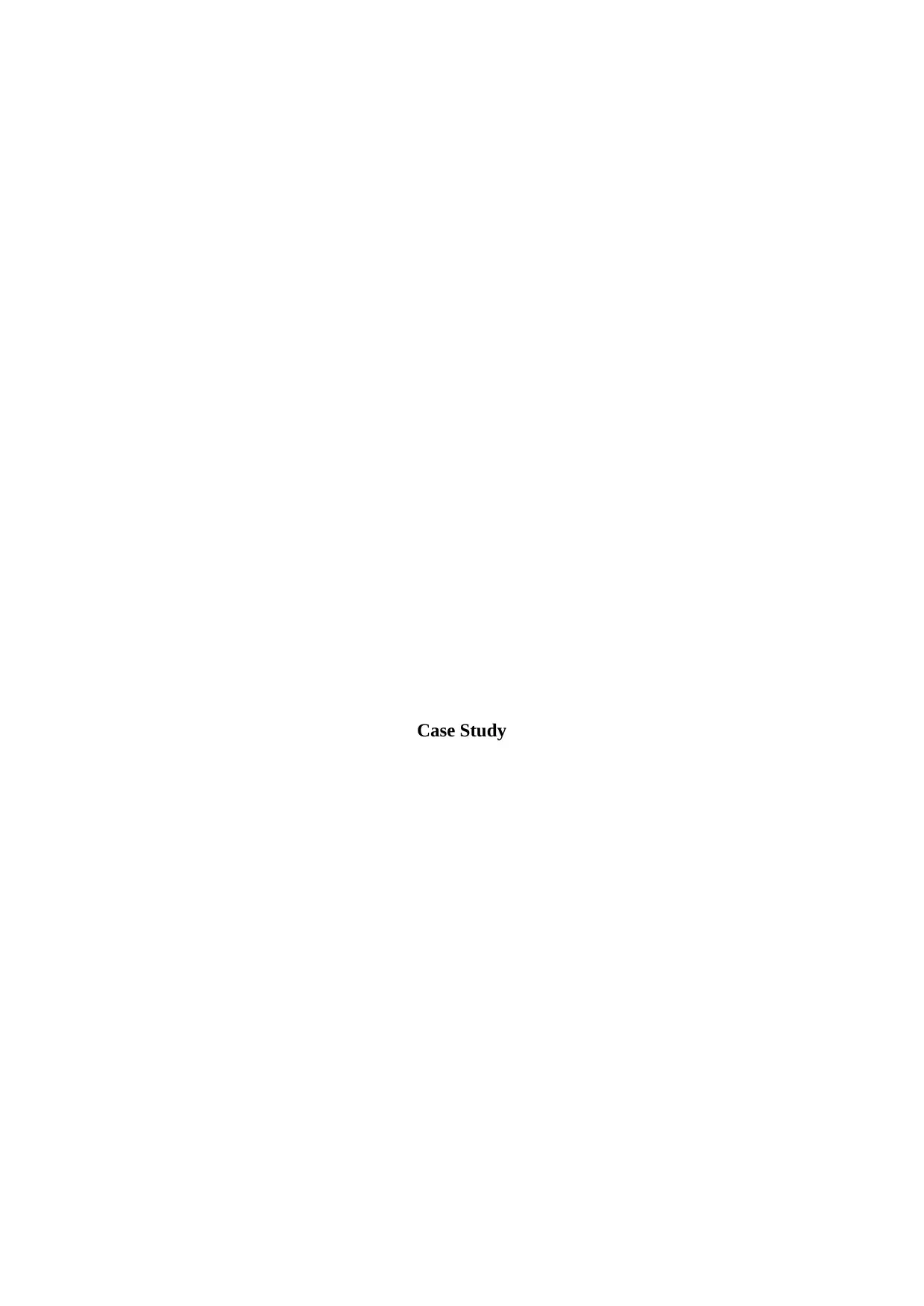
Case Study
Secure Best Marks with AI Grader
Need help grading? Try our AI Grader for instant feedback on your assignments.
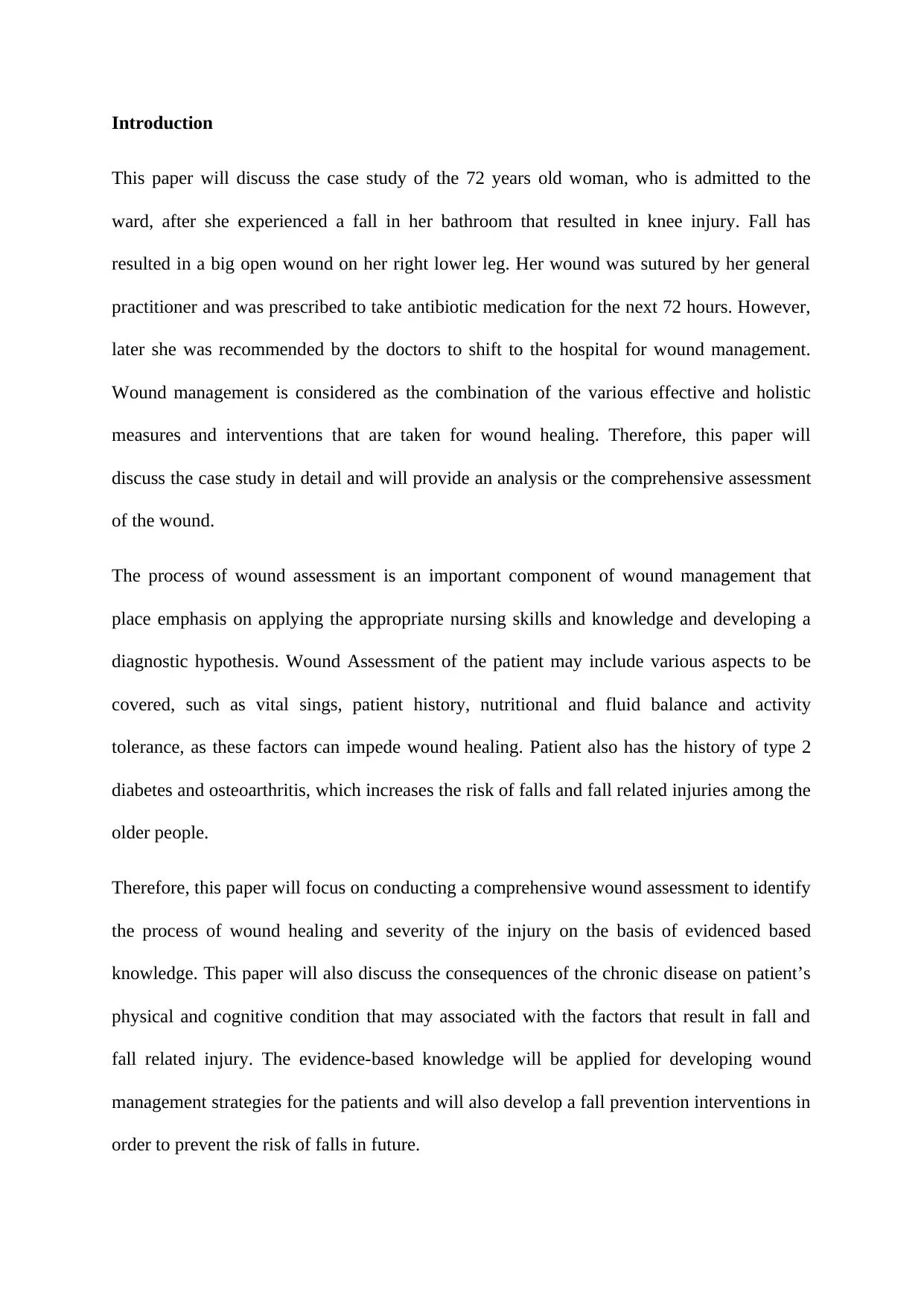
Introduction
This paper will discuss the case study of the 72 years old woman, who is admitted to the
ward, after she experienced a fall in her bathroom that resulted in knee injury. Fall has
resulted in a big open wound on her right lower leg. Her wound was sutured by her general
practitioner and was prescribed to take antibiotic medication for the next 72 hours. However,
later she was recommended by the doctors to shift to the hospital for wound management.
Wound management is considered as the combination of the various effective and holistic
measures and interventions that are taken for wound healing. Therefore, this paper will
discuss the case study in detail and will provide an analysis or the comprehensive assessment
of the wound.
The process of wound assessment is an important component of wound management that
place emphasis on applying the appropriate nursing skills and knowledge and developing a
diagnostic hypothesis. Wound Assessment of the patient may include various aspects to be
covered, such as vital sings, patient history, nutritional and fluid balance and activity
tolerance, as these factors can impede wound healing. Patient also has the history of type 2
diabetes and osteoarthritis, which increases the risk of falls and fall related injuries among the
older people.
Therefore, this paper will focus on conducting a comprehensive wound assessment to identify
the process of wound healing and severity of the injury on the basis of evidenced based
knowledge. This paper will also discuss the consequences of the chronic disease on patient’s
physical and cognitive condition that may associated with the factors that result in fall and
fall related injury. The evidence-based knowledge will be applied for developing wound
management strategies for the patients and will also develop a fall prevention interventions in
order to prevent the risk of falls in future.
This paper will discuss the case study of the 72 years old woman, who is admitted to the
ward, after she experienced a fall in her bathroom that resulted in knee injury. Fall has
resulted in a big open wound on her right lower leg. Her wound was sutured by her general
practitioner and was prescribed to take antibiotic medication for the next 72 hours. However,
later she was recommended by the doctors to shift to the hospital for wound management.
Wound management is considered as the combination of the various effective and holistic
measures and interventions that are taken for wound healing. Therefore, this paper will
discuss the case study in detail and will provide an analysis or the comprehensive assessment
of the wound.
The process of wound assessment is an important component of wound management that
place emphasis on applying the appropriate nursing skills and knowledge and developing a
diagnostic hypothesis. Wound Assessment of the patient may include various aspects to be
covered, such as vital sings, patient history, nutritional and fluid balance and activity
tolerance, as these factors can impede wound healing. Patient also has the history of type 2
diabetes and osteoarthritis, which increases the risk of falls and fall related injuries among the
older people.
Therefore, this paper will focus on conducting a comprehensive wound assessment to identify
the process of wound healing and severity of the injury on the basis of evidenced based
knowledge. This paper will also discuss the consequences of the chronic disease on patient’s
physical and cognitive condition that may associated with the factors that result in fall and
fall related injury. The evidence-based knowledge will be applied for developing wound
management strategies for the patients and will also develop a fall prevention interventions in
order to prevent the risk of falls in future.
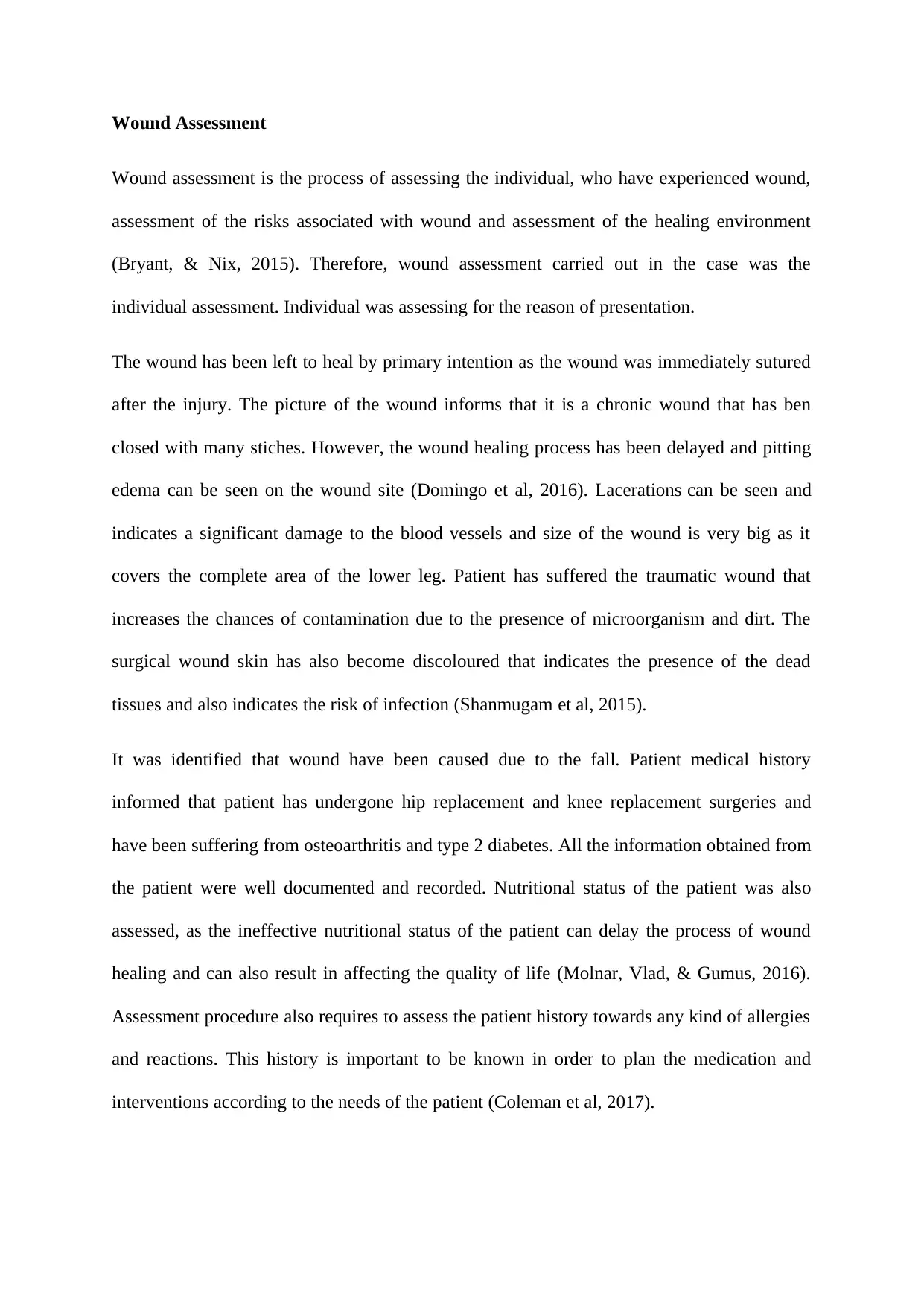
Wound Assessment
Wound assessment is the process of assessing the individual, who have experienced wound,
assessment of the risks associated with wound and assessment of the healing environment
(Bryant, & Nix, 2015). Therefore, wound assessment carried out in the case was the
individual assessment. Individual was assessing for the reason of presentation.
The wound has been left to heal by primary intention as the wound was immediately sutured
after the injury. The picture of the wound informs that it is a chronic wound that has ben
closed with many stiches. However, the wound healing process has been delayed and pitting
edema can be seen on the wound site (Domingo et al, 2016). Lacerations can be seen and
indicates a significant damage to the blood vessels and size of the wound is very big as it
covers the complete area of the lower leg. Patient has suffered the traumatic wound that
increases the chances of contamination due to the presence of microorganism and dirt. The
surgical wound skin has also become discoloured that indicates the presence of the dead
tissues and also indicates the risk of infection (Shanmugam et al, 2015).
It was identified that wound have been caused due to the fall. Patient medical history
informed that patient has undergone hip replacement and knee replacement surgeries and
have been suffering from osteoarthritis and type 2 diabetes. All the information obtained from
the patient were well documented and recorded. Nutritional status of the patient was also
assessed, as the ineffective nutritional status of the patient can delay the process of wound
healing and can also result in affecting the quality of life (Molnar, Vlad, & Gumus, 2016).
Assessment procedure also requires to assess the patient history towards any kind of allergies
and reactions. This history is important to be known in order to plan the medication and
interventions according to the needs of the patient (Coleman et al, 2017).
Wound assessment is the process of assessing the individual, who have experienced wound,
assessment of the risks associated with wound and assessment of the healing environment
(Bryant, & Nix, 2015). Therefore, wound assessment carried out in the case was the
individual assessment. Individual was assessing for the reason of presentation.
The wound has been left to heal by primary intention as the wound was immediately sutured
after the injury. The picture of the wound informs that it is a chronic wound that has ben
closed with many stiches. However, the wound healing process has been delayed and pitting
edema can be seen on the wound site (Domingo et al, 2016). Lacerations can be seen and
indicates a significant damage to the blood vessels and size of the wound is very big as it
covers the complete area of the lower leg. Patient has suffered the traumatic wound that
increases the chances of contamination due to the presence of microorganism and dirt. The
surgical wound skin has also become discoloured that indicates the presence of the dead
tissues and also indicates the risk of infection (Shanmugam et al, 2015).
It was identified that wound have been caused due to the fall. Patient medical history
informed that patient has undergone hip replacement and knee replacement surgeries and
have been suffering from osteoarthritis and type 2 diabetes. All the information obtained from
the patient were well documented and recorded. Nutritional status of the patient was also
assessed, as the ineffective nutritional status of the patient can delay the process of wound
healing and can also result in affecting the quality of life (Molnar, Vlad, & Gumus, 2016).
Assessment procedure also requires to assess the patient history towards any kind of allergies
and reactions. This history is important to be known in order to plan the medication and
interventions according to the needs of the patient (Coleman et al, 2017).
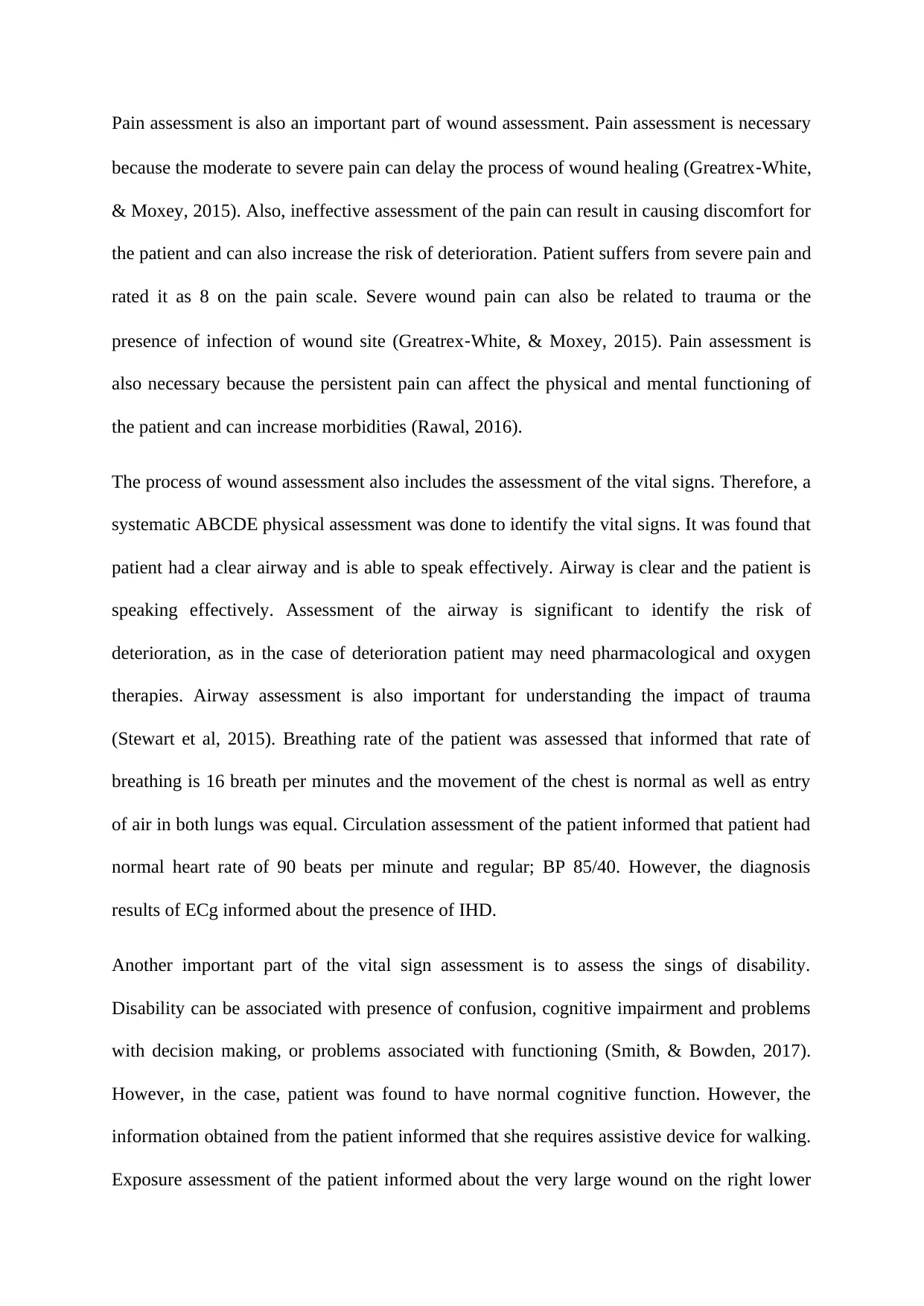
Pain assessment is also an important part of wound assessment. Pain assessment is necessary
because the moderate to severe pain can delay the process of wound healing (Greatrex‐White,
& Moxey, 2015). Also, ineffective assessment of the pain can result in causing discomfort for
the patient and can also increase the risk of deterioration. Patient suffers from severe pain and
rated it as 8 on the pain scale. Severe wound pain can also be related to trauma or the
presence of infection of wound site (Greatrex‐White, & Moxey, 2015). Pain assessment is
also necessary because the persistent pain can affect the physical and mental functioning of
the patient and can increase morbidities (Rawal, 2016).
The process of wound assessment also includes the assessment of the vital signs. Therefore, a
systematic ABCDE physical assessment was done to identify the vital signs. It was found that
patient had a clear airway and is able to speak effectively. Airway is clear and the patient is
speaking effectively. Assessment of the airway is significant to identify the risk of
deterioration, as in the case of deterioration patient may need pharmacological and oxygen
therapies. Airway assessment is also important for understanding the impact of trauma
(Stewart et al, 2015). Breathing rate of the patient was assessed that informed that rate of
breathing is 16 breath per minutes and the movement of the chest is normal as well as entry
of air in both lungs was equal. Circulation assessment of the patient informed that patient had
normal heart rate of 90 beats per minute and regular; BP 85/40. However, the diagnosis
results of ECg informed about the presence of IHD.
Another important part of the vital sign assessment is to assess the sings of disability.
Disability can be associated with presence of confusion, cognitive impairment and problems
with decision making, or problems associated with functioning (Smith, & Bowden, 2017).
However, in the case, patient was found to have normal cognitive function. However, the
information obtained from the patient informed that she requires assistive device for walking.
Exposure assessment of the patient informed about the very large wound on the right lower
because the moderate to severe pain can delay the process of wound healing (Greatrex‐White,
& Moxey, 2015). Also, ineffective assessment of the pain can result in causing discomfort for
the patient and can also increase the risk of deterioration. Patient suffers from severe pain and
rated it as 8 on the pain scale. Severe wound pain can also be related to trauma or the
presence of infection of wound site (Greatrex‐White, & Moxey, 2015). Pain assessment is
also necessary because the persistent pain can affect the physical and mental functioning of
the patient and can increase morbidities (Rawal, 2016).
The process of wound assessment also includes the assessment of the vital signs. Therefore, a
systematic ABCDE physical assessment was done to identify the vital signs. It was found that
patient had a clear airway and is able to speak effectively. Airway is clear and the patient is
speaking effectively. Assessment of the airway is significant to identify the risk of
deterioration, as in the case of deterioration patient may need pharmacological and oxygen
therapies. Airway assessment is also important for understanding the impact of trauma
(Stewart et al, 2015). Breathing rate of the patient was assessed that informed that rate of
breathing is 16 breath per minutes and the movement of the chest is normal as well as entry
of air in both lungs was equal. Circulation assessment of the patient informed that patient had
normal heart rate of 90 beats per minute and regular; BP 85/40. However, the diagnosis
results of ECg informed about the presence of IHD.
Another important part of the vital sign assessment is to assess the sings of disability.
Disability can be associated with presence of confusion, cognitive impairment and problems
with decision making, or problems associated with functioning (Smith, & Bowden, 2017).
However, in the case, patient was found to have normal cognitive function. However, the
information obtained from the patient informed that she requires assistive device for walking.
Exposure assessment of the patient informed about the very large wound on the right lower
Secure Best Marks with AI Grader
Need help grading? Try our AI Grader for instant feedback on your assignments.
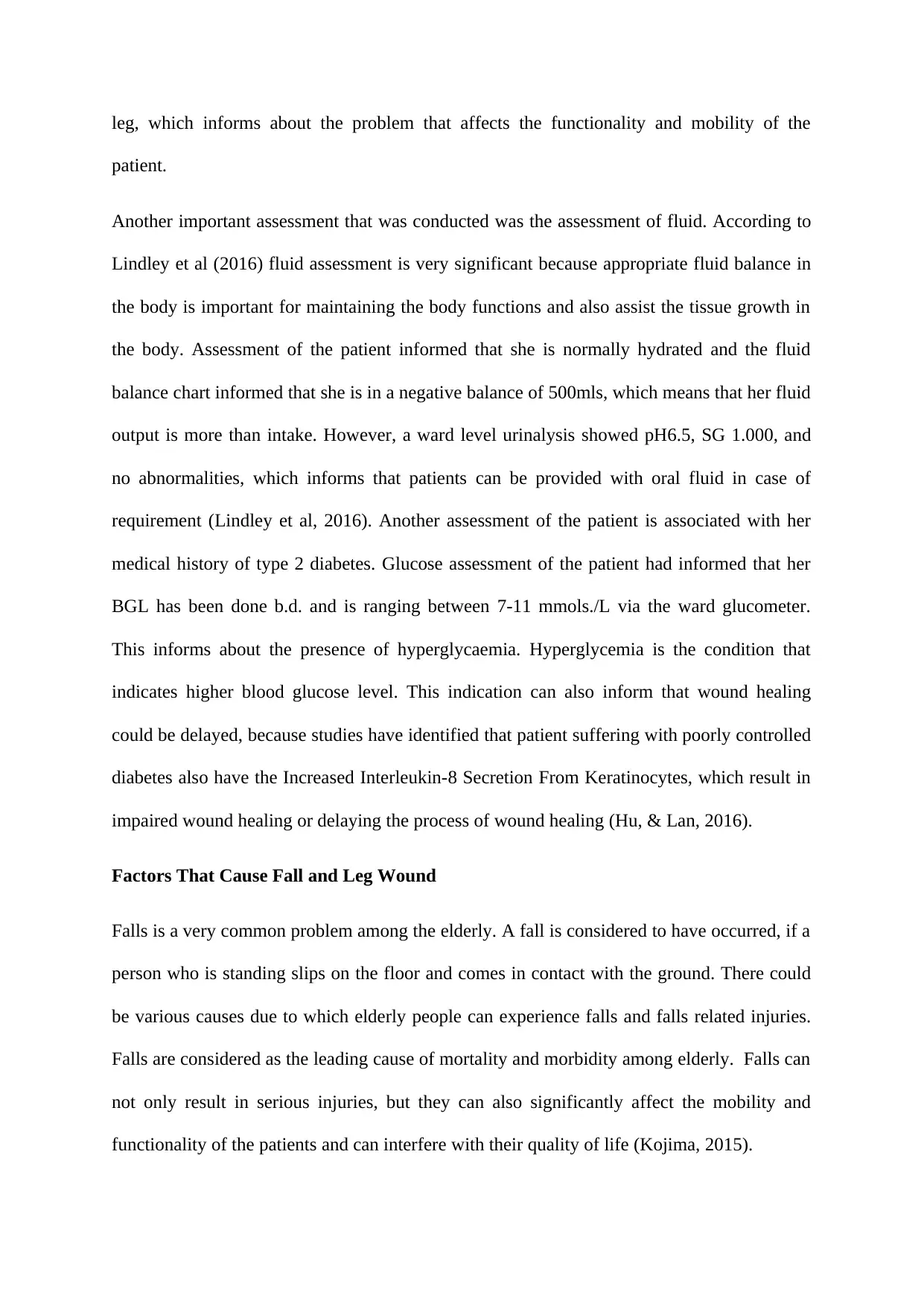
leg, which informs about the problem that affects the functionality and mobility of the
patient.
Another important assessment that was conducted was the assessment of fluid. According to
Lindley et al (2016) fluid assessment is very significant because appropriate fluid balance in
the body is important for maintaining the body functions and also assist the tissue growth in
the body. Assessment of the patient informed that she is normally hydrated and the fluid
balance chart informed that she is in a negative balance of 500mls, which means that her fluid
output is more than intake. However, a ward level urinalysis showed pH6.5, SG 1.000, and
no abnormalities, which informs that patients can be provided with oral fluid in case of
requirement (Lindley et al, 2016). Another assessment of the patient is associated with her
medical history of type 2 diabetes. Glucose assessment of the patient had informed that her
BGL has been done b.d. and is ranging between 7-11 mmols./L via the ward glucometer.
This informs about the presence of hyperglycaemia. Hyperglycemia is the condition that
indicates higher blood glucose level. This indication can also inform that wound healing
could be delayed, because studies have identified that patient suffering with poorly controlled
diabetes also have the Increased Interleukin-8 Secretion From Keratinocytes, which result in
impaired wound healing or delaying the process of wound healing (Hu, & Lan, 2016).
Factors That Cause Fall and Leg Wound
Falls is a very common problem among the elderly. A fall is considered to have occurred, if a
person who is standing slips on the floor and comes in contact with the ground. There could
be various causes due to which elderly people can experience falls and falls related injuries.
Falls are considered as the leading cause of mortality and morbidity among elderly. Falls can
not only result in serious injuries, but they can also significantly affect the mobility and
functionality of the patients and can interfere with their quality of life (Kojima, 2015).
patient.
Another important assessment that was conducted was the assessment of fluid. According to
Lindley et al (2016) fluid assessment is very significant because appropriate fluid balance in
the body is important for maintaining the body functions and also assist the tissue growth in
the body. Assessment of the patient informed that she is normally hydrated and the fluid
balance chart informed that she is in a negative balance of 500mls, which means that her fluid
output is more than intake. However, a ward level urinalysis showed pH6.5, SG 1.000, and
no abnormalities, which informs that patients can be provided with oral fluid in case of
requirement (Lindley et al, 2016). Another assessment of the patient is associated with her
medical history of type 2 diabetes. Glucose assessment of the patient had informed that her
BGL has been done b.d. and is ranging between 7-11 mmols./L via the ward glucometer.
This informs about the presence of hyperglycaemia. Hyperglycemia is the condition that
indicates higher blood glucose level. This indication can also inform that wound healing
could be delayed, because studies have identified that patient suffering with poorly controlled
diabetes also have the Increased Interleukin-8 Secretion From Keratinocytes, which result in
impaired wound healing or delaying the process of wound healing (Hu, & Lan, 2016).
Factors That Cause Fall and Leg Wound
Falls is a very common problem among the elderly. A fall is considered to have occurred, if a
person who is standing slips on the floor and comes in contact with the ground. There could
be various causes due to which elderly people can experience falls and falls related injuries.
Falls are considered as the leading cause of mortality and morbidity among elderly. Falls can
not only result in serious injuries, but they can also significantly affect the mobility and
functionality of the patients and can interfere with their quality of life (Kojima, 2015).
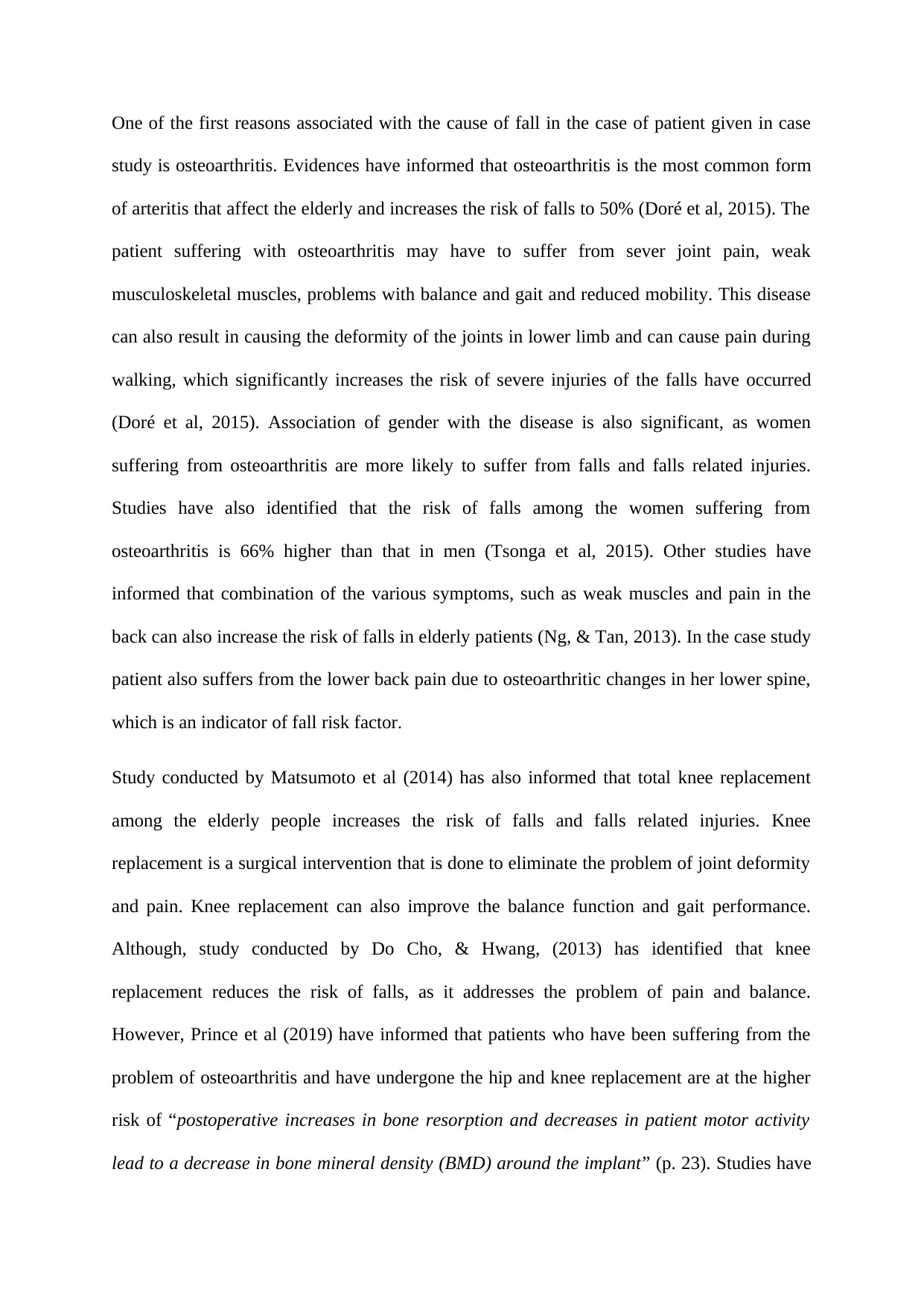
One of the first reasons associated with the cause of fall in the case of patient given in case
study is osteoarthritis. Evidences have informed that osteoarthritis is the most common form
of arteritis that affect the elderly and increases the risk of falls to 50% (Doré et al, 2015). The
patient suffering with osteoarthritis may have to suffer from sever joint pain, weak
musculoskeletal muscles, problems with balance and gait and reduced mobility. This disease
can also result in causing the deformity of the joints in lower limb and can cause pain during
walking, which significantly increases the risk of severe injuries of the falls have occurred
(Doré et al, 2015). Association of gender with the disease is also significant, as women
suffering from osteoarthritis are more likely to suffer from falls and falls related injuries.
Studies have also identified that the risk of falls among the women suffering from
osteoarthritis is 66% higher than that in men (Tsonga et al, 2015). Other studies have
informed that combination of the various symptoms, such as weak muscles and pain in the
back can also increase the risk of falls in elderly patients (Ng, & Tan, 2013). In the case study
patient also suffers from the lower back pain due to osteoarthritic changes in her lower spine,
which is an indicator of fall risk factor.
Study conducted by Matsumoto et al (2014) has also informed that total knee replacement
among the elderly people increases the risk of falls and falls related injuries. Knee
replacement is a surgical intervention that is done to eliminate the problem of joint deformity
and pain. Knee replacement can also improve the balance function and gait performance.
Although, study conducted by Do Cho, & Hwang, (2013) has identified that knee
replacement reduces the risk of falls, as it addresses the problem of pain and balance.
However, Prince et al (2019) have informed that patients who have been suffering from the
problem of osteoarthritis and have undergone the hip and knee replacement are at the higher
risk of “postoperative increases in bone resorption and decreases in patient motor activity
lead to a decrease in bone mineral density (BMD) around the implant” (p. 23). Studies have
study is osteoarthritis. Evidences have informed that osteoarthritis is the most common form
of arteritis that affect the elderly and increases the risk of falls to 50% (Doré et al, 2015). The
patient suffering with osteoarthritis may have to suffer from sever joint pain, weak
musculoskeletal muscles, problems with balance and gait and reduced mobility. This disease
can also result in causing the deformity of the joints in lower limb and can cause pain during
walking, which significantly increases the risk of severe injuries of the falls have occurred
(Doré et al, 2015). Association of gender with the disease is also significant, as women
suffering from osteoarthritis are more likely to suffer from falls and falls related injuries.
Studies have also identified that the risk of falls among the women suffering from
osteoarthritis is 66% higher than that in men (Tsonga et al, 2015). Other studies have
informed that combination of the various symptoms, such as weak muscles and pain in the
back can also increase the risk of falls in elderly patients (Ng, & Tan, 2013). In the case study
patient also suffers from the lower back pain due to osteoarthritic changes in her lower spine,
which is an indicator of fall risk factor.
Study conducted by Matsumoto et al (2014) has also informed that total knee replacement
among the elderly people increases the risk of falls and falls related injuries. Knee
replacement is a surgical intervention that is done to eliminate the problem of joint deformity
and pain. Knee replacement can also improve the balance function and gait performance.
Although, study conducted by Do Cho, & Hwang, (2013) has identified that knee
replacement reduces the risk of falls, as it addresses the problem of pain and balance.
However, Prince et al (2019) have informed that patients who have been suffering from the
problem of osteoarthritis and have undergone the hip and knee replacement are at the higher
risk of “postoperative increases in bone resorption and decreases in patient motor activity
lead to a decrease in bone mineral density (BMD) around the implant” (p. 23). Studies have
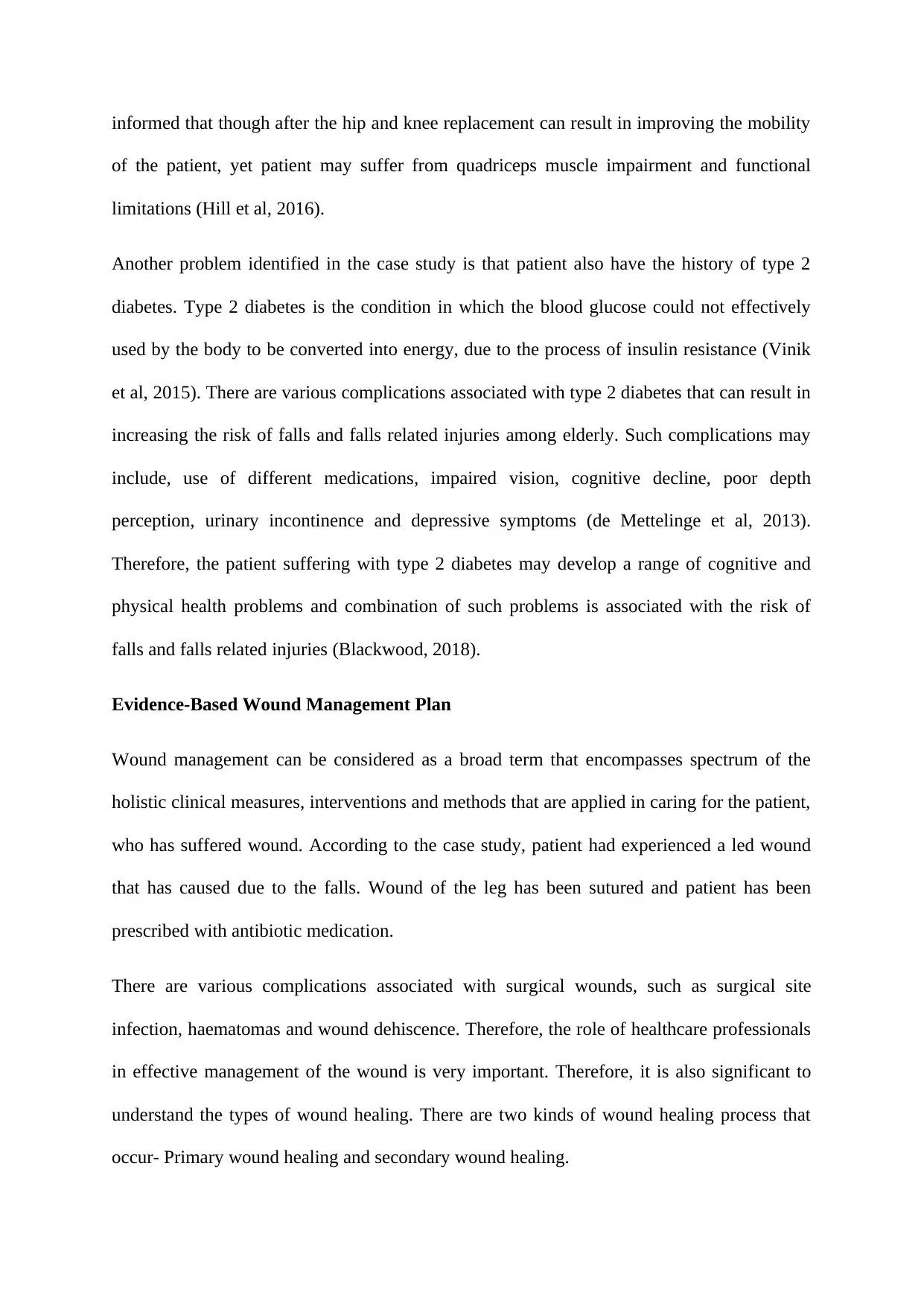
informed that though after the hip and knee replacement can result in improving the mobility
of the patient, yet patient may suffer from quadriceps muscle impairment and functional
limitations (Hill et al, 2016).
Another problem identified in the case study is that patient also have the history of type 2
diabetes. Type 2 diabetes is the condition in which the blood glucose could not effectively
used by the body to be converted into energy, due to the process of insulin resistance (Vinik
et al, 2015). There are various complications associated with type 2 diabetes that can result in
increasing the risk of falls and falls related injuries among elderly. Such complications may
include, use of different medications, impaired vision, cognitive decline, poor depth
perception, urinary incontinence and depressive symptoms (de Mettelinge et al, 2013).
Therefore, the patient suffering with type 2 diabetes may develop a range of cognitive and
physical health problems and combination of such problems is associated with the risk of
falls and falls related injuries (Blackwood, 2018).
Evidence-Based Wound Management Plan
Wound management can be considered as a broad term that encompasses spectrum of the
holistic clinical measures, interventions and methods that are applied in caring for the patient,
who has suffered wound. According to the case study, patient had experienced a led wound
that has caused due to the falls. Wound of the leg has been sutured and patient has been
prescribed with antibiotic medication.
There are various complications associated with surgical wounds, such as surgical site
infection, haematomas and wound dehiscence. Therefore, the role of healthcare professionals
in effective management of the wound is very important. Therefore, it is also significant to
understand the types of wound healing. There are two kinds of wound healing process that
occur- Primary wound healing and secondary wound healing.
of the patient, yet patient may suffer from quadriceps muscle impairment and functional
limitations (Hill et al, 2016).
Another problem identified in the case study is that patient also have the history of type 2
diabetes. Type 2 diabetes is the condition in which the blood glucose could not effectively
used by the body to be converted into energy, due to the process of insulin resistance (Vinik
et al, 2015). There are various complications associated with type 2 diabetes that can result in
increasing the risk of falls and falls related injuries among elderly. Such complications may
include, use of different medications, impaired vision, cognitive decline, poor depth
perception, urinary incontinence and depressive symptoms (de Mettelinge et al, 2013).
Therefore, the patient suffering with type 2 diabetes may develop a range of cognitive and
physical health problems and combination of such problems is associated with the risk of
falls and falls related injuries (Blackwood, 2018).
Evidence-Based Wound Management Plan
Wound management can be considered as a broad term that encompasses spectrum of the
holistic clinical measures, interventions and methods that are applied in caring for the patient,
who has suffered wound. According to the case study, patient had experienced a led wound
that has caused due to the falls. Wound of the leg has been sutured and patient has been
prescribed with antibiotic medication.
There are various complications associated with surgical wounds, such as surgical site
infection, haematomas and wound dehiscence. Therefore, the role of healthcare professionals
in effective management of the wound is very important. Therefore, it is also significant to
understand the types of wound healing. There are two kinds of wound healing process that
occur- Primary wound healing and secondary wound healing.
Paraphrase This Document
Need a fresh take? Get an instant paraphrase of this document with our AI Paraphraser
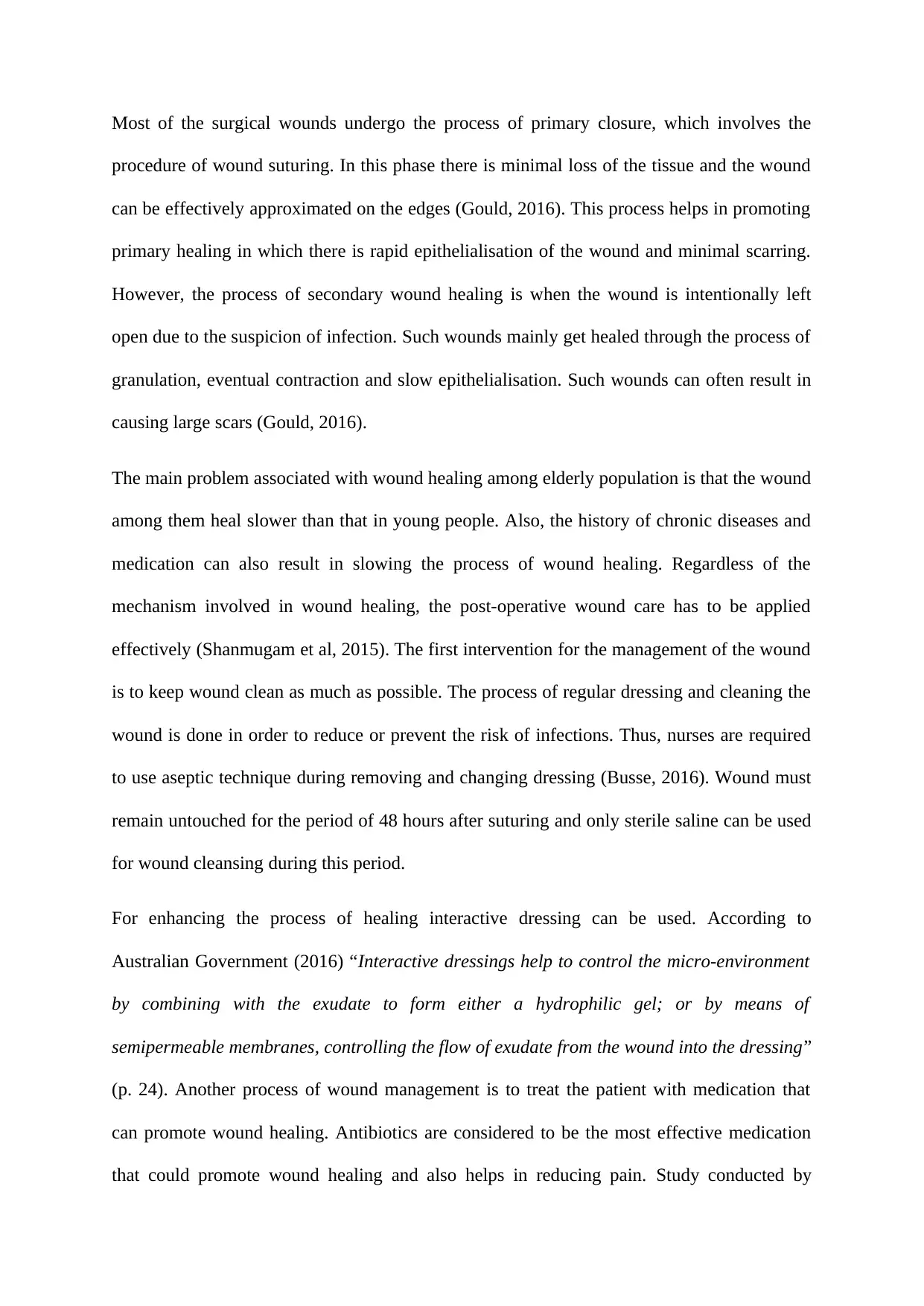
Most of the surgical wounds undergo the process of primary closure, which involves the
procedure of wound suturing. In this phase there is minimal loss of the tissue and the wound
can be effectively approximated on the edges (Gould, 2016). This process helps in promoting
primary healing in which there is rapid epithelialisation of the wound and minimal scarring.
However, the process of secondary wound healing is when the wound is intentionally left
open due to the suspicion of infection. Such wounds mainly get healed through the process of
granulation, eventual contraction and slow epithelialisation. Such wounds can often result in
causing large scars (Gould, 2016).
The main problem associated with wound healing among elderly population is that the wound
among them heal slower than that in young people. Also, the history of chronic diseases and
medication can also result in slowing the process of wound healing. Regardless of the
mechanism involved in wound healing, the post-operative wound care has to be applied
effectively (Shanmugam et al, 2015). The first intervention for the management of the wound
is to keep wound clean as much as possible. The process of regular dressing and cleaning the
wound is done in order to reduce or prevent the risk of infections. Thus, nurses are required
to use aseptic technique during removing and changing dressing (Busse, 2016). Wound must
remain untouched for the period of 48 hours after suturing and only sterile saline can be used
for wound cleansing during this period.
For enhancing the process of healing interactive dressing can be used. According to
Australian Government (2016) “Interactive dressings help to control the micro-environment
by combining with the exudate to form either a hydrophilic gel; or by means of
semipermeable membranes, controlling the flow of exudate from the wound into the dressing”
(p. 24). Another process of wound management is to treat the patient with medication that
can promote wound healing. Antibiotics are considered to be the most effective medication
that could promote wound healing and also helps in reducing pain. Study conducted by
procedure of wound suturing. In this phase there is minimal loss of the tissue and the wound
can be effectively approximated on the edges (Gould, 2016). This process helps in promoting
primary healing in which there is rapid epithelialisation of the wound and minimal scarring.
However, the process of secondary wound healing is when the wound is intentionally left
open due to the suspicion of infection. Such wounds mainly get healed through the process of
granulation, eventual contraction and slow epithelialisation. Such wounds can often result in
causing large scars (Gould, 2016).
The main problem associated with wound healing among elderly population is that the wound
among them heal slower than that in young people. Also, the history of chronic diseases and
medication can also result in slowing the process of wound healing. Regardless of the
mechanism involved in wound healing, the post-operative wound care has to be applied
effectively (Shanmugam et al, 2015). The first intervention for the management of the wound
is to keep wound clean as much as possible. The process of regular dressing and cleaning the
wound is done in order to reduce or prevent the risk of infections. Thus, nurses are required
to use aseptic technique during removing and changing dressing (Busse, 2016). Wound must
remain untouched for the period of 48 hours after suturing and only sterile saline can be used
for wound cleansing during this period.
For enhancing the process of healing interactive dressing can be used. According to
Australian Government (2016) “Interactive dressings help to control the micro-environment
by combining with the exudate to form either a hydrophilic gel; or by means of
semipermeable membranes, controlling the flow of exudate from the wound into the dressing”
(p. 24). Another process of wound management is to treat the patient with medication that
can promote wound healing. Antibiotics are considered to be the most effective medication
that could promote wound healing and also helps in reducing pain. Study conducted by
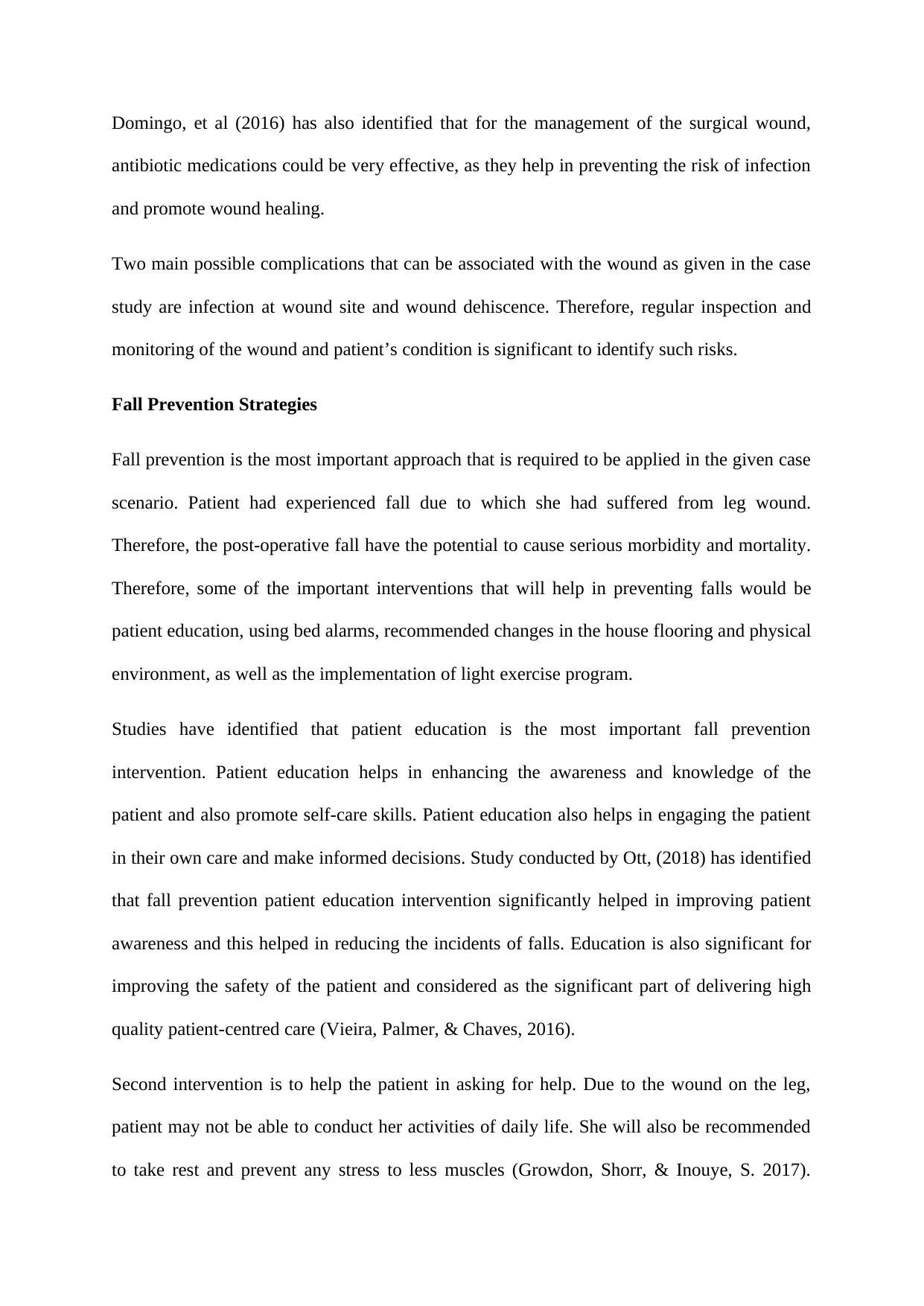
Domingo, et al (2016) has also identified that for the management of the surgical wound,
antibiotic medications could be very effective, as they help in preventing the risk of infection
and promote wound healing.
Two main possible complications that can be associated with the wound as given in the case
study are infection at wound site and wound dehiscence. Therefore, regular inspection and
monitoring of the wound and patient’s condition is significant to identify such risks.
Fall Prevention Strategies
Fall prevention is the most important approach that is required to be applied in the given case
scenario. Patient had experienced fall due to which she had suffered from leg wound.
Therefore, the post-operative fall have the potential to cause serious morbidity and mortality.
Therefore, some of the important interventions that will help in preventing falls would be
patient education, using bed alarms, recommended changes in the house flooring and physical
environment, as well as the implementation of light exercise program.
Studies have identified that patient education is the most important fall prevention
intervention. Patient education helps in enhancing the awareness and knowledge of the
patient and also promote self-care skills. Patient education also helps in engaging the patient
in their own care and make informed decisions. Study conducted by Ott, (2018) has identified
that fall prevention patient education intervention significantly helped in improving patient
awareness and this helped in reducing the incidents of falls. Education is also significant for
improving the safety of the patient and considered as the significant part of delivering high
quality patient-centred care (Vieira, Palmer, & Chaves, 2016).
Second intervention is to help the patient in asking for help. Due to the wound on the leg,
patient may not be able to conduct her activities of daily life. She will also be recommended
to take rest and prevent any stress to less muscles (Growdon, Shorr, & Inouye, S. 2017).
antibiotic medications could be very effective, as they help in preventing the risk of infection
and promote wound healing.
Two main possible complications that can be associated with the wound as given in the case
study are infection at wound site and wound dehiscence. Therefore, regular inspection and
monitoring of the wound and patient’s condition is significant to identify such risks.
Fall Prevention Strategies
Fall prevention is the most important approach that is required to be applied in the given case
scenario. Patient had experienced fall due to which she had suffered from leg wound.
Therefore, the post-operative fall have the potential to cause serious morbidity and mortality.
Therefore, some of the important interventions that will help in preventing falls would be
patient education, using bed alarms, recommended changes in the house flooring and physical
environment, as well as the implementation of light exercise program.
Studies have identified that patient education is the most important fall prevention
intervention. Patient education helps in enhancing the awareness and knowledge of the
patient and also promote self-care skills. Patient education also helps in engaging the patient
in their own care and make informed decisions. Study conducted by Ott, (2018) has identified
that fall prevention patient education intervention significantly helped in improving patient
awareness and this helped in reducing the incidents of falls. Education is also significant for
improving the safety of the patient and considered as the significant part of delivering high
quality patient-centred care (Vieira, Palmer, & Chaves, 2016).
Second intervention is to help the patient in asking for help. Due to the wound on the leg,
patient may not be able to conduct her activities of daily life. She will also be recommended
to take rest and prevent any stress to less muscles (Growdon, Shorr, & Inouye, S. 2017).
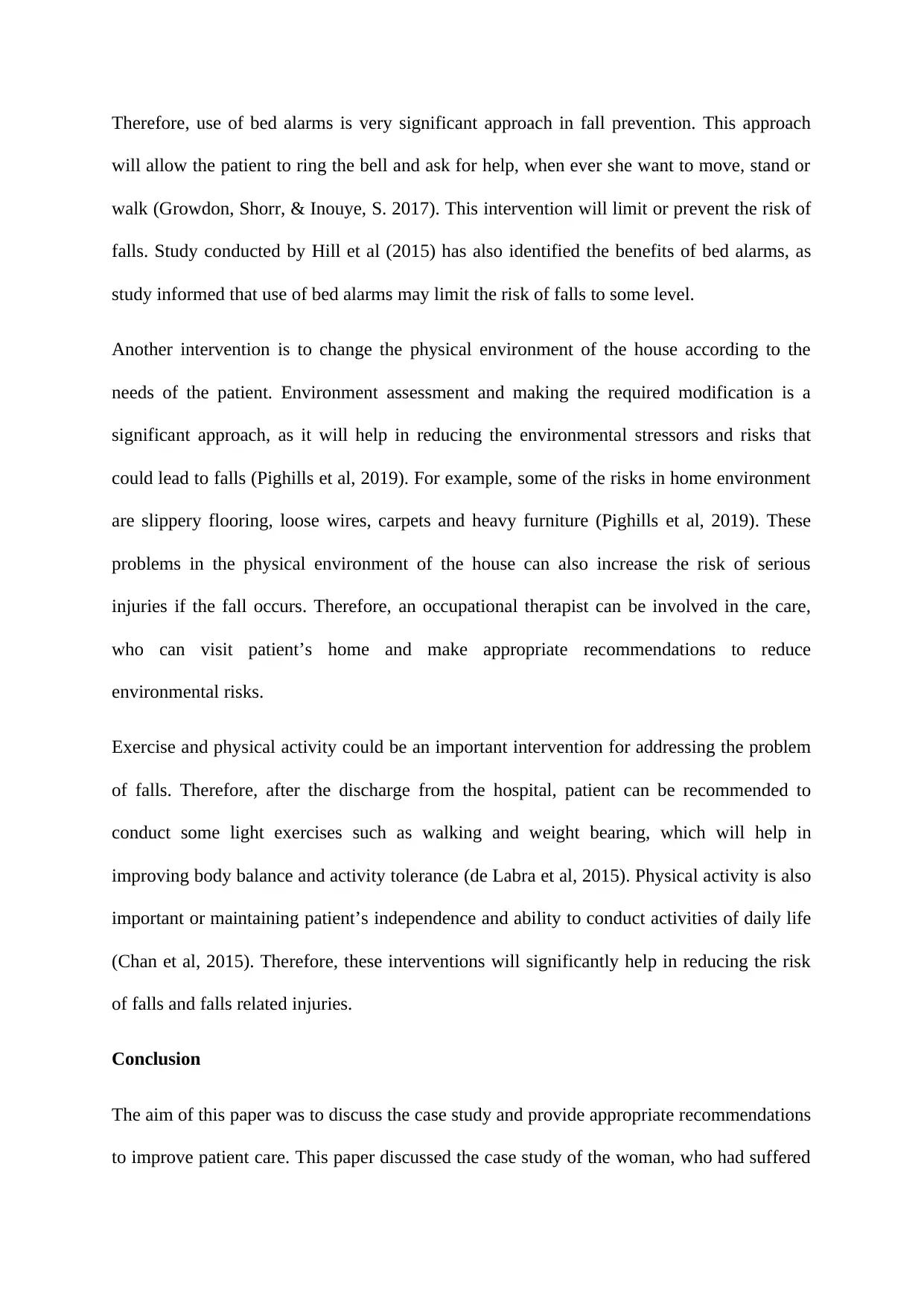
Therefore, use of bed alarms is very significant approach in fall prevention. This approach
will allow the patient to ring the bell and ask for help, when ever she want to move, stand or
walk (Growdon, Shorr, & Inouye, S. 2017). This intervention will limit or prevent the risk of
falls. Study conducted by Hill et al (2015) has also identified the benefits of bed alarms, as
study informed that use of bed alarms may limit the risk of falls to some level.
Another intervention is to change the physical environment of the house according to the
needs of the patient. Environment assessment and making the required modification is a
significant approach, as it will help in reducing the environmental stressors and risks that
could lead to falls (Pighills et al, 2019). For example, some of the risks in home environment
are slippery flooring, loose wires, carpets and heavy furniture (Pighills et al, 2019). These
problems in the physical environment of the house can also increase the risk of serious
injuries if the fall occurs. Therefore, an occupational therapist can be involved in the care,
who can visit patient’s home and make appropriate recommendations to reduce
environmental risks.
Exercise and physical activity could be an important intervention for addressing the problem
of falls. Therefore, after the discharge from the hospital, patient can be recommended to
conduct some light exercises such as walking and weight bearing, which will help in
improving body balance and activity tolerance (de Labra et al, 2015). Physical activity is also
important or maintaining patient’s independence and ability to conduct activities of daily life
(Chan et al, 2015). Therefore, these interventions will significantly help in reducing the risk
of falls and falls related injuries.
Conclusion
The aim of this paper was to discuss the case study and provide appropriate recommendations
to improve patient care. This paper discussed the case study of the woman, who had suffered
will allow the patient to ring the bell and ask for help, when ever she want to move, stand or
walk (Growdon, Shorr, & Inouye, S. 2017). This intervention will limit or prevent the risk of
falls. Study conducted by Hill et al (2015) has also identified the benefits of bed alarms, as
study informed that use of bed alarms may limit the risk of falls to some level.
Another intervention is to change the physical environment of the house according to the
needs of the patient. Environment assessment and making the required modification is a
significant approach, as it will help in reducing the environmental stressors and risks that
could lead to falls (Pighills et al, 2019). For example, some of the risks in home environment
are slippery flooring, loose wires, carpets and heavy furniture (Pighills et al, 2019). These
problems in the physical environment of the house can also increase the risk of serious
injuries if the fall occurs. Therefore, an occupational therapist can be involved in the care,
who can visit patient’s home and make appropriate recommendations to reduce
environmental risks.
Exercise and physical activity could be an important intervention for addressing the problem
of falls. Therefore, after the discharge from the hospital, patient can be recommended to
conduct some light exercises such as walking and weight bearing, which will help in
improving body balance and activity tolerance (de Labra et al, 2015). Physical activity is also
important or maintaining patient’s independence and ability to conduct activities of daily life
(Chan et al, 2015). Therefore, these interventions will significantly help in reducing the risk
of falls and falls related injuries.
Conclusion
The aim of this paper was to discuss the case study and provide appropriate recommendations
to improve patient care. This paper discussed the case study of the woman, who had suffered
Secure Best Marks with AI Grader
Need help grading? Try our AI Grader for instant feedback on your assignments.

leg wound, as she experienced fall. Medical history of the patient has shown a significant
connection of falls with her medical history. However, the main care priority identified in the
case scenario is the management of the wound. Therefore, this paper discussed a
comprehensive and evidence based wound assessment that is significant for effective care
planning and wound management. This study concluded that wound assessment of the patient
must be comprehensive and must include all significant factors including patient history, pain
score, current condition, wound condition and chronic disease history of patient.
Wound management strategies and interventions included in this paper are based on the
evidence-based knowledge gained from the comprehensive review of literature. Wound
management is a significant priority that is determined in the case scenario as it is associated
with patient’s well-being and quality of life. Patient suffering from type 2 diabetes are often
vulnerable to cognitive decline and falls. Therefore, the comprehensive assessment
significantly helps in improving wound care management. The main reason behind the
wound was the fall that patient suffered. Therefore, a comprehensive understanding of fall
prevention strategies was significant. This paper discussed the fall prevention strategies that
would help patient, while she is hospitalised and will also help the patient when she is
discharged from the hospital. Appropriate assessment, management and prevention of the
problems that can risk patient’s well-being is significant in the case of elderly population.
References
Australian Government. (2016). DVA Wound Care Module. Retrieved from:
https://www.dva.gov.au/sites/default/files/files/providers/woundcare/
woundcaremodule.pdf
connection of falls with her medical history. However, the main care priority identified in the
case scenario is the management of the wound. Therefore, this paper discussed a
comprehensive and evidence based wound assessment that is significant for effective care
planning and wound management. This study concluded that wound assessment of the patient
must be comprehensive and must include all significant factors including patient history, pain
score, current condition, wound condition and chronic disease history of patient.
Wound management strategies and interventions included in this paper are based on the
evidence-based knowledge gained from the comprehensive review of literature. Wound
management is a significant priority that is determined in the case scenario as it is associated
with patient’s well-being and quality of life. Patient suffering from type 2 diabetes are often
vulnerable to cognitive decline and falls. Therefore, the comprehensive assessment
significantly helps in improving wound care management. The main reason behind the
wound was the fall that patient suffered. Therefore, a comprehensive understanding of fall
prevention strategies was significant. This paper discussed the fall prevention strategies that
would help patient, while she is hospitalised and will also help the patient when she is
discharged from the hospital. Appropriate assessment, management and prevention of the
problems that can risk patient’s well-being is significant in the case of elderly population.
References
Australian Government. (2016). DVA Wound Care Module. Retrieved from:
https://www.dva.gov.au/sites/default/files/files/providers/woundcare/
woundcaremodule.pdf
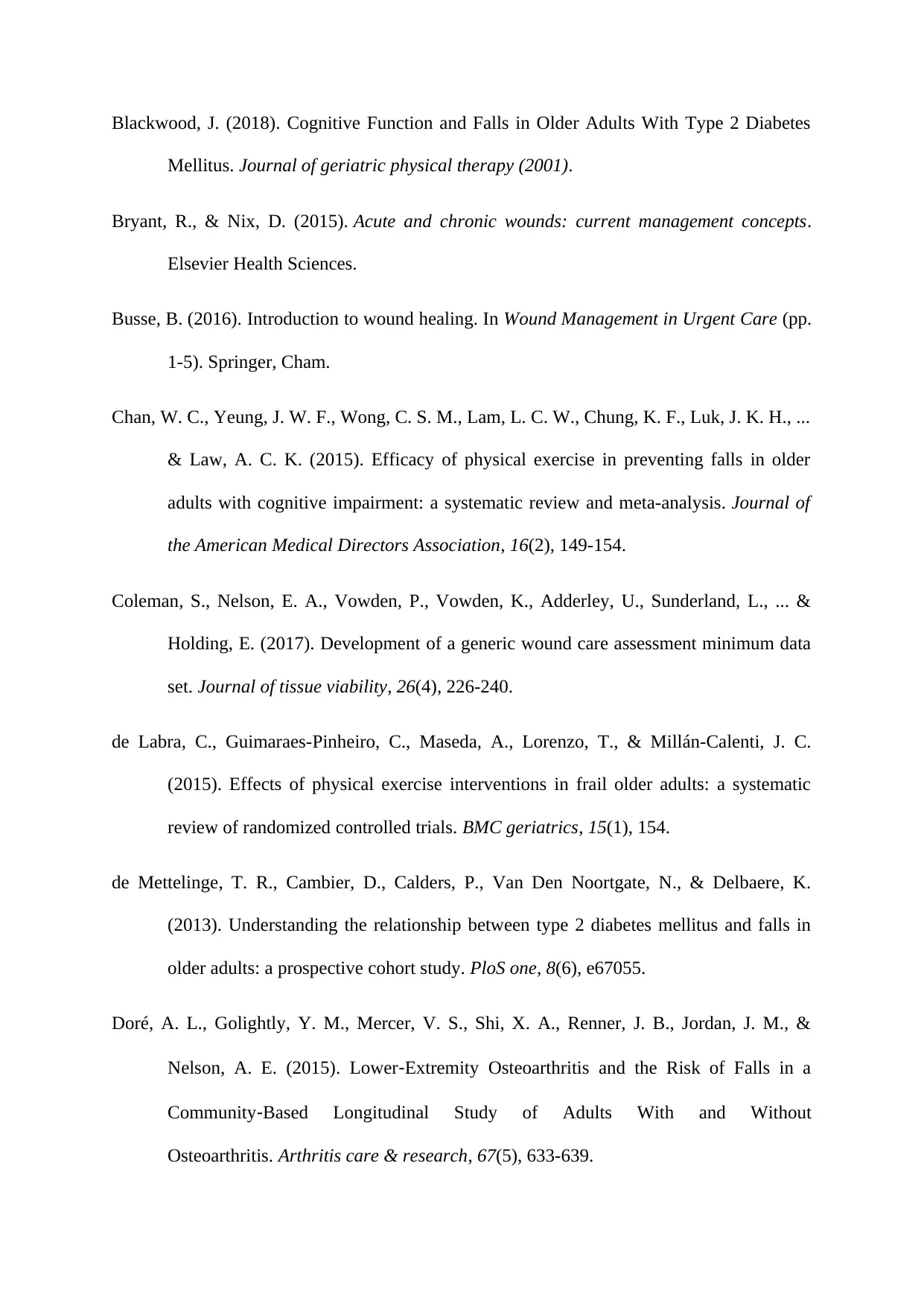
Blackwood, J. (2018). Cognitive Function and Falls in Older Adults With Type 2 Diabetes
Mellitus. Journal of geriatric physical therapy (2001).
Bryant, R., & Nix, D. (2015). Acute and chronic wounds: current management concepts.
Elsevier Health Sciences.
Busse, B. (2016). Introduction to wound healing. In Wound Management in Urgent Care (pp.
1-5). Springer, Cham.
Chan, W. C., Yeung, J. W. F., Wong, C. S. M., Lam, L. C. W., Chung, K. F., Luk, J. K. H., ...
& Law, A. C. K. (2015). Efficacy of physical exercise in preventing falls in older
adults with cognitive impairment: a systematic review and meta-analysis. Journal of
the American Medical Directors Association, 16(2), 149-154.
Coleman, S., Nelson, E. A., Vowden, P., Vowden, K., Adderley, U., Sunderland, L., ... &
Holding, E. (2017). Development of a generic wound care assessment minimum data
set. Journal of tissue viability, 26(4), 226-240.
de Labra, C., Guimaraes-Pinheiro, C., Maseda, A., Lorenzo, T., & Millán-Calenti, J. C.
(2015). Effects of physical exercise interventions in frail older adults: a systematic
review of randomized controlled trials. BMC geriatrics, 15(1), 154.
de Mettelinge, T. R., Cambier, D., Calders, P., Van Den Noortgate, N., & Delbaere, K.
(2013). Understanding the relationship between type 2 diabetes mellitus and falls in
older adults: a prospective cohort study. PloS one, 8(6), e67055.
Doré, A. L., Golightly, Y. M., Mercer, V. S., Shi, X. A., Renner, J. B., Jordan, J. M., &
Nelson, A. E. (2015). Lower‐Extremity Osteoarthritis and the Risk of Falls in a
Community‐Based Longitudinal Study of Adults With and Without
Osteoarthritis. Arthritis care & research, 67(5), 633-639.
Mellitus. Journal of geriatric physical therapy (2001).
Bryant, R., & Nix, D. (2015). Acute and chronic wounds: current management concepts.
Elsevier Health Sciences.
Busse, B. (2016). Introduction to wound healing. In Wound Management in Urgent Care (pp.
1-5). Springer, Cham.
Chan, W. C., Yeung, J. W. F., Wong, C. S. M., Lam, L. C. W., Chung, K. F., Luk, J. K. H., ...
& Law, A. C. K. (2015). Efficacy of physical exercise in preventing falls in older
adults with cognitive impairment: a systematic review and meta-analysis. Journal of
the American Medical Directors Association, 16(2), 149-154.
Coleman, S., Nelson, E. A., Vowden, P., Vowden, K., Adderley, U., Sunderland, L., ... &
Holding, E. (2017). Development of a generic wound care assessment minimum data
set. Journal of tissue viability, 26(4), 226-240.
de Labra, C., Guimaraes-Pinheiro, C., Maseda, A., Lorenzo, T., & Millán-Calenti, J. C.
(2015). Effects of physical exercise interventions in frail older adults: a systematic
review of randomized controlled trials. BMC geriatrics, 15(1), 154.
de Mettelinge, T. R., Cambier, D., Calders, P., Van Den Noortgate, N., & Delbaere, K.
(2013). Understanding the relationship between type 2 diabetes mellitus and falls in
older adults: a prospective cohort study. PloS one, 8(6), e67055.
Doré, A. L., Golightly, Y. M., Mercer, V. S., Shi, X. A., Renner, J. B., Jordan, J. M., &
Nelson, A. E. (2015). Lower‐Extremity Osteoarthritis and the Risk of Falls in a
Community‐Based Longitudinal Study of Adults With and Without
Osteoarthritis. Arthritis care & research, 67(5), 633-639.
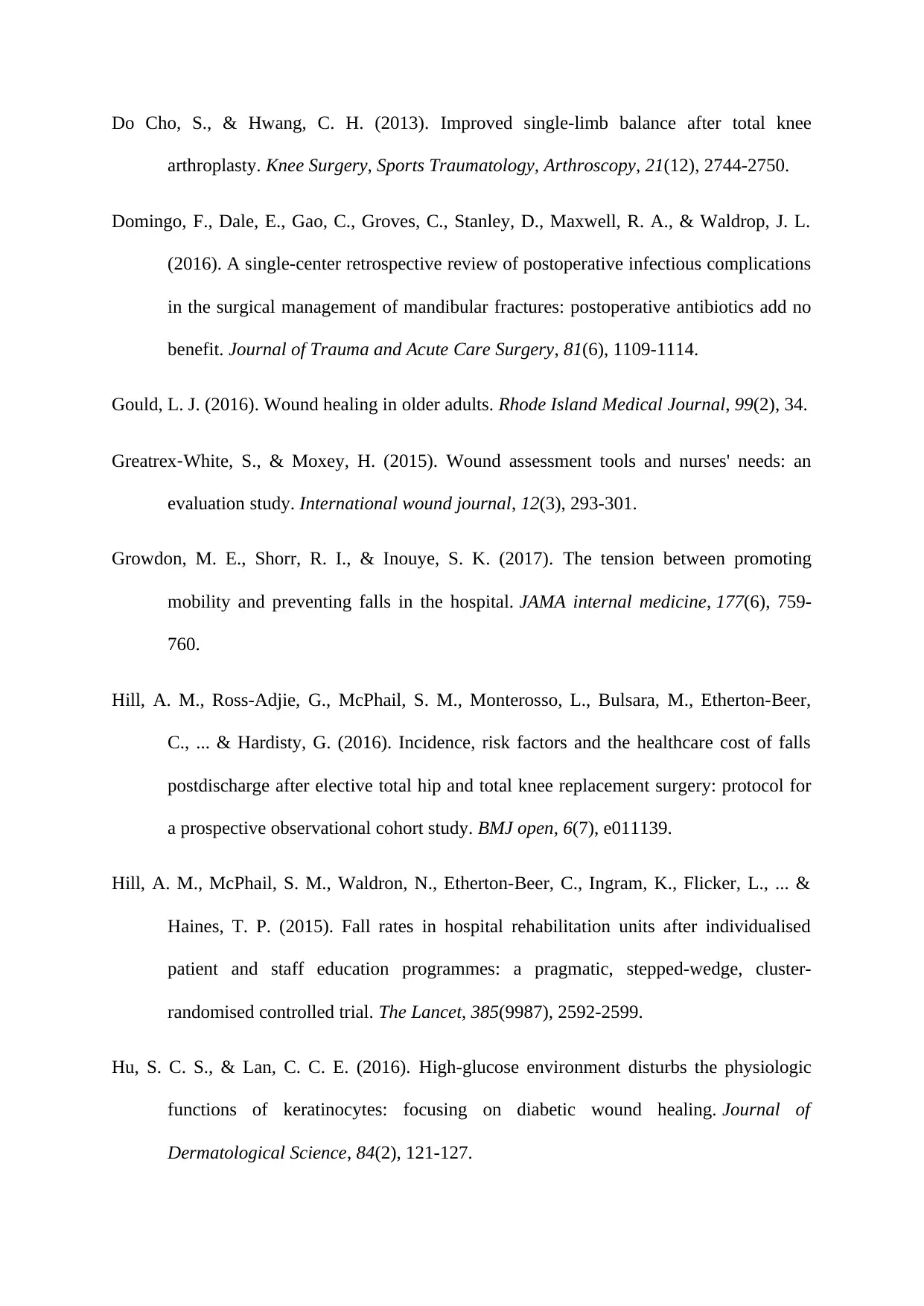
Do Cho, S., & Hwang, C. H. (2013). Improved single-limb balance after total knee
arthroplasty. Knee Surgery, Sports Traumatology, Arthroscopy, 21(12), 2744-2750.
Domingo, F., Dale, E., Gao, C., Groves, C., Stanley, D., Maxwell, R. A., & Waldrop, J. L.
(2016). A single-center retrospective review of postoperative infectious complications
in the surgical management of mandibular fractures: postoperative antibiotics add no
benefit. Journal of Trauma and Acute Care Surgery, 81(6), 1109-1114.
Gould, L. J. (2016). Wound healing in older adults. Rhode Island Medical Journal, 99(2), 34.
Greatrex‐White, S., & Moxey, H. (2015). Wound assessment tools and nurses' needs: an
evaluation study. International wound journal, 12(3), 293-301.
Growdon, M. E., Shorr, R. I., & Inouye, S. K. (2017). The tension between promoting
mobility and preventing falls in the hospital. JAMA internal medicine, 177(6), 759-
760.
Hill, A. M., Ross-Adjie, G., McPhail, S. M., Monterosso, L., Bulsara, M., Etherton-Beer,
C., ... & Hardisty, G. (2016). Incidence, risk factors and the healthcare cost of falls
postdischarge after elective total hip and total knee replacement surgery: protocol for
a prospective observational cohort study. BMJ open, 6(7), e011139.
Hill, A. M., McPhail, S. M., Waldron, N., Etherton-Beer, C., Ingram, K., Flicker, L., ... &
Haines, T. P. (2015). Fall rates in hospital rehabilitation units after individualised
patient and staff education programmes: a pragmatic, stepped-wedge, cluster-
randomised controlled trial. The Lancet, 385(9987), 2592-2599.
Hu, S. C. S., & Lan, C. C. E. (2016). High-glucose environment disturbs the physiologic
functions of keratinocytes: focusing on diabetic wound healing. Journal of
Dermatological Science, 84(2), 121-127.
arthroplasty. Knee Surgery, Sports Traumatology, Arthroscopy, 21(12), 2744-2750.
Domingo, F., Dale, E., Gao, C., Groves, C., Stanley, D., Maxwell, R. A., & Waldrop, J. L.
(2016). A single-center retrospective review of postoperative infectious complications
in the surgical management of mandibular fractures: postoperative antibiotics add no
benefit. Journal of Trauma and Acute Care Surgery, 81(6), 1109-1114.
Gould, L. J. (2016). Wound healing in older adults. Rhode Island Medical Journal, 99(2), 34.
Greatrex‐White, S., & Moxey, H. (2015). Wound assessment tools and nurses' needs: an
evaluation study. International wound journal, 12(3), 293-301.
Growdon, M. E., Shorr, R. I., & Inouye, S. K. (2017). The tension between promoting
mobility and preventing falls in the hospital. JAMA internal medicine, 177(6), 759-
760.
Hill, A. M., Ross-Adjie, G., McPhail, S. M., Monterosso, L., Bulsara, M., Etherton-Beer,
C., ... & Hardisty, G. (2016). Incidence, risk factors and the healthcare cost of falls
postdischarge after elective total hip and total knee replacement surgery: protocol for
a prospective observational cohort study. BMJ open, 6(7), e011139.
Hill, A. M., McPhail, S. M., Waldron, N., Etherton-Beer, C., Ingram, K., Flicker, L., ... &
Haines, T. P. (2015). Fall rates in hospital rehabilitation units after individualised
patient and staff education programmes: a pragmatic, stepped-wedge, cluster-
randomised controlled trial. The Lancet, 385(9987), 2592-2599.
Hu, S. C. S., & Lan, C. C. E. (2016). High-glucose environment disturbs the physiologic
functions of keratinocytes: focusing on diabetic wound healing. Journal of
Dermatological Science, 84(2), 121-127.
Paraphrase This Document
Need a fresh take? Get an instant paraphrase of this document with our AI Paraphraser
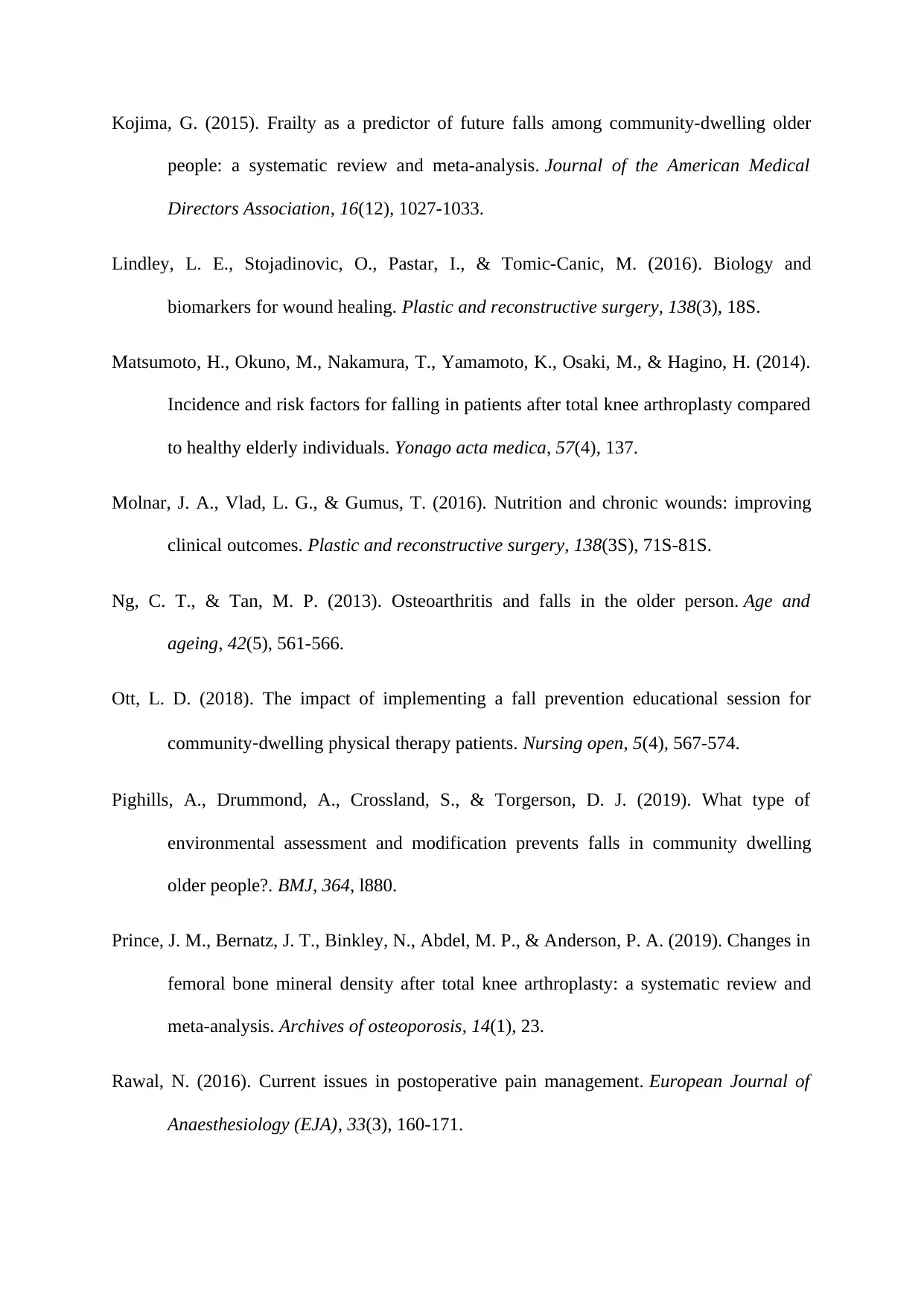
Kojima, G. (2015). Frailty as a predictor of future falls among community-dwelling older
people: a systematic review and meta-analysis. Journal of the American Medical
Directors Association, 16(12), 1027-1033.
Lindley, L. E., Stojadinovic, O., Pastar, I., & Tomic-Canic, M. (2016). Biology and
biomarkers for wound healing. Plastic and reconstructive surgery, 138(3), 18S.
Matsumoto, H., Okuno, M., Nakamura, T., Yamamoto, K., Osaki, M., & Hagino, H. (2014).
Incidence and risk factors for falling in patients after total knee arthroplasty compared
to healthy elderly individuals. Yonago acta medica, 57(4), 137.
Molnar, J. A., Vlad, L. G., & Gumus, T. (2016). Nutrition and chronic wounds: improving
clinical outcomes. Plastic and reconstructive surgery, 138(3S), 71S-81S.
Ng, C. T., & Tan, M. P. (2013). Osteoarthritis and falls in the older person. Age and
ageing, 42(5), 561-566.
Ott, L. D. (2018). The impact of implementing a fall prevention educational session for
community‐dwelling physical therapy patients. Nursing open, 5(4), 567-574.
Pighills, A., Drummond, A., Crossland, S., & Torgerson, D. J. (2019). What type of
environmental assessment and modification prevents falls in community dwelling
older people?. BMJ, 364, l880.
Prince, J. M., Bernatz, J. T., Binkley, N., Abdel, M. P., & Anderson, P. A. (2019). Changes in
femoral bone mineral density after total knee arthroplasty: a systematic review and
meta-analysis. Archives of osteoporosis, 14(1), 23.
Rawal, N. (2016). Current issues in postoperative pain management. European Journal of
Anaesthesiology (EJA), 33(3), 160-171.
people: a systematic review and meta-analysis. Journal of the American Medical
Directors Association, 16(12), 1027-1033.
Lindley, L. E., Stojadinovic, O., Pastar, I., & Tomic-Canic, M. (2016). Biology and
biomarkers for wound healing. Plastic and reconstructive surgery, 138(3), 18S.
Matsumoto, H., Okuno, M., Nakamura, T., Yamamoto, K., Osaki, M., & Hagino, H. (2014).
Incidence and risk factors for falling in patients after total knee arthroplasty compared
to healthy elderly individuals. Yonago acta medica, 57(4), 137.
Molnar, J. A., Vlad, L. G., & Gumus, T. (2016). Nutrition and chronic wounds: improving
clinical outcomes. Plastic and reconstructive surgery, 138(3S), 71S-81S.
Ng, C. T., & Tan, M. P. (2013). Osteoarthritis and falls in the older person. Age and
ageing, 42(5), 561-566.
Ott, L. D. (2018). The impact of implementing a fall prevention educational session for
community‐dwelling physical therapy patients. Nursing open, 5(4), 567-574.
Pighills, A., Drummond, A., Crossland, S., & Torgerson, D. J. (2019). What type of
environmental assessment and modification prevents falls in community dwelling
older people?. BMJ, 364, l880.
Prince, J. M., Bernatz, J. T., Binkley, N., Abdel, M. P., & Anderson, P. A. (2019). Changes in
femoral bone mineral density after total knee arthroplasty: a systematic review and
meta-analysis. Archives of osteoporosis, 14(1), 23.
Rawal, N. (2016). Current issues in postoperative pain management. European Journal of
Anaesthesiology (EJA), 33(3), 160-171.
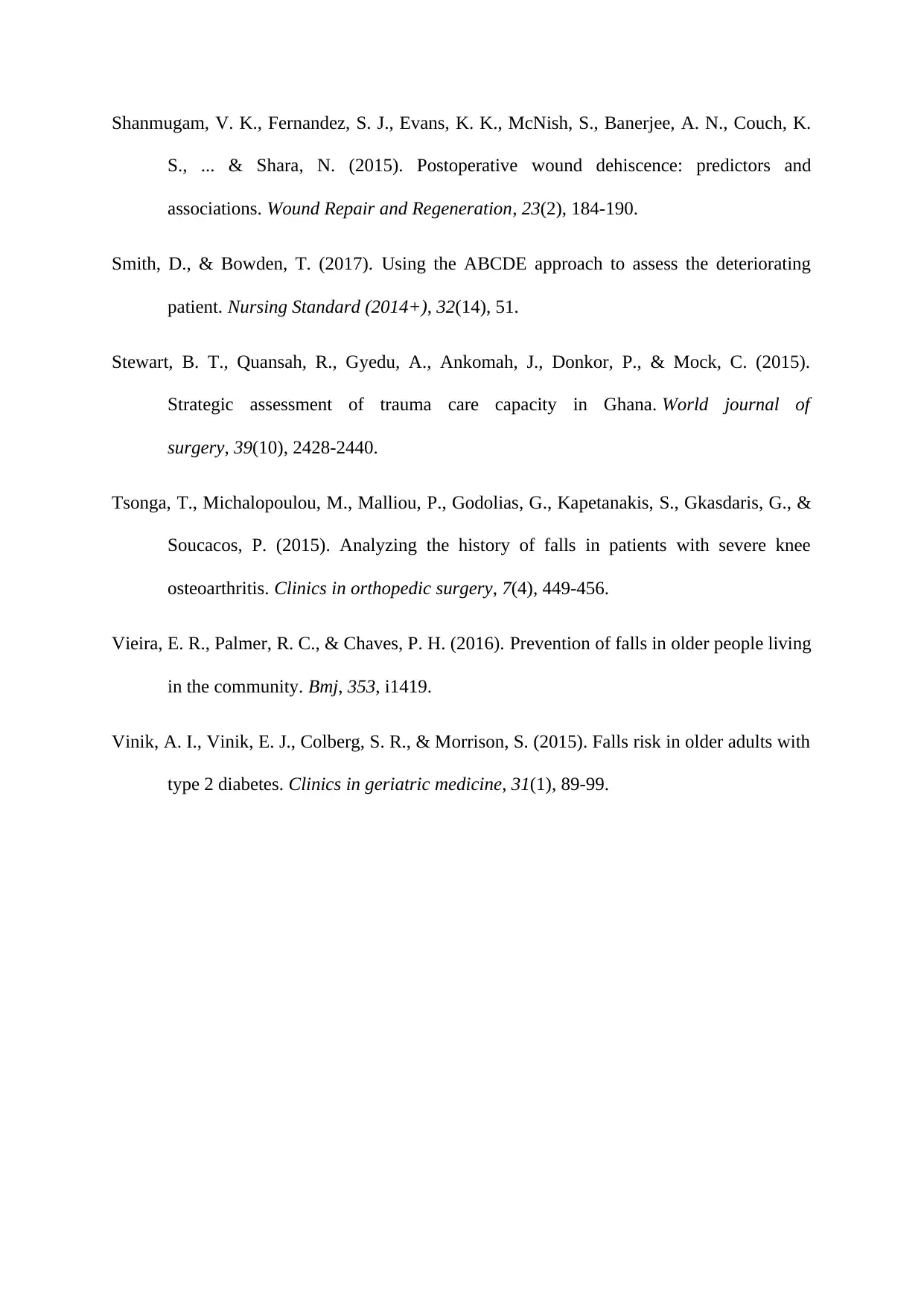
Shanmugam, V. K., Fernandez, S. J., Evans, K. K., McNish, S., Banerjee, A. N., Couch, K.
S., ... & Shara, N. (2015). Postoperative wound dehiscence: predictors and
associations. Wound Repair and Regeneration, 23(2), 184-190.
Smith, D., & Bowden, T. (2017). Using the ABCDE approach to assess the deteriorating
patient. Nursing Standard (2014+), 32(14), 51.
Stewart, B. T., Quansah, R., Gyedu, A., Ankomah, J., Donkor, P., & Mock, C. (2015).
Strategic assessment of trauma care capacity in Ghana. World journal of
surgery, 39(10), 2428-2440.
Tsonga, T., Michalopoulou, M., Malliou, P., Godolias, G., Kapetanakis, S., Gkasdaris, G., &
Soucacos, P. (2015). Analyzing the history of falls in patients with severe knee
osteoarthritis. Clinics in orthopedic surgery, 7(4), 449-456.
Vieira, E. R., Palmer, R. C., & Chaves, P. H. (2016). Prevention of falls in older people living
in the community. Bmj, 353, i1419.
Vinik, A. I., Vinik, E. J., Colberg, S. R., & Morrison, S. (2015). Falls risk in older adults with
type 2 diabetes. Clinics in geriatric medicine, 31(1), 89-99.
S., ... & Shara, N. (2015). Postoperative wound dehiscence: predictors and
associations. Wound Repair and Regeneration, 23(2), 184-190.
Smith, D., & Bowden, T. (2017). Using the ABCDE approach to assess the deteriorating
patient. Nursing Standard (2014+), 32(14), 51.
Stewart, B. T., Quansah, R., Gyedu, A., Ankomah, J., Donkor, P., & Mock, C. (2015).
Strategic assessment of trauma care capacity in Ghana. World journal of
surgery, 39(10), 2428-2440.
Tsonga, T., Michalopoulou, M., Malliou, P., Godolias, G., Kapetanakis, S., Gkasdaris, G., &
Soucacos, P. (2015). Analyzing the history of falls in patients with severe knee
osteoarthritis. Clinics in orthopedic surgery, 7(4), 449-456.
Vieira, E. R., Palmer, R. C., & Chaves, P. H. (2016). Prevention of falls in older people living
in the community. Bmj, 353, i1419.
Vinik, A. I., Vinik, E. J., Colberg, S. R., & Morrison, S. (2015). Falls risk in older adults with
type 2 diabetes. Clinics in geriatric medicine, 31(1), 89-99.
1 out of 15
Related Documents
Your All-in-One AI-Powered Toolkit for Academic Success.
+13062052269
info@desklib.com
Available 24*7 on WhatsApp / Email
![[object Object]](/_next/static/media/star-bottom.7253800d.svg)
Unlock your academic potential
© 2024 | Zucol Services PVT LTD | All rights reserved.




